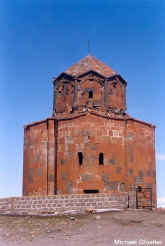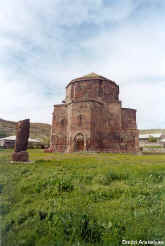|

|
A right turn in Tsamakasar leads to Zarnja,
in N part of which is 7th c. S.
Khach church, rebuilt in the 10th c. |
|
Continuing the main road N instead of the left turnoff to Talin and
taking the first turnoff to Mastara,
the road leads toward an excellent early
church of S. Hovhannes on the E edge of the village. On the S wall outside a fragmentary Greek
inscription seems to mention the Sasanid
king Peroz (reign 459-484),
suggesting a 5th century date,
but
|

|
|
|
|
other building inscriptions indicate that the bulk
of
the church is 7th century with later repairs. According to popular etymology, Mastara derives its
name from
Gregory the Illuminator, who brought back from Caesaria the relics of
John the Baptist, one fragment of which he enshrined beneath the church
site: Mas (a piece), Tara (I buried). The church was closed in 1935 and used as the collective farm
storehouse until it was reopened in 1993. S from S. Hovhannes church,
among the houses is standing the small chapel
of S. Nshan. The village is very rich with different
khachkars, among of which is the Mastara Large khachkar
of the 13th
century, one of the bests in Armenia, standing on the SE edge
of the village, on a hill, seems to be a prehistoric settlement
with traces of fortification wall. Just on the right is standing
another beautiful
khachkar, occupied with interesting shaped gravestones.
Series of beautiful khachkars
and gravestones (including modern ones) with a ruined
chapel, are standing in the cemetery of the
village. NE from the village, atop of a hill is the famous Nakhavka
(or Naxavik) shrine and fort
remains.
|